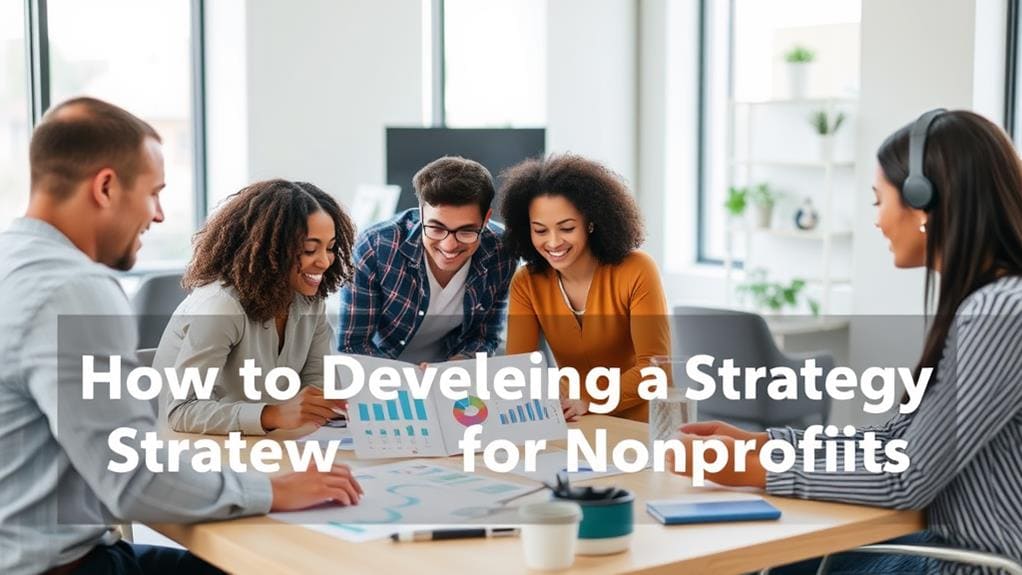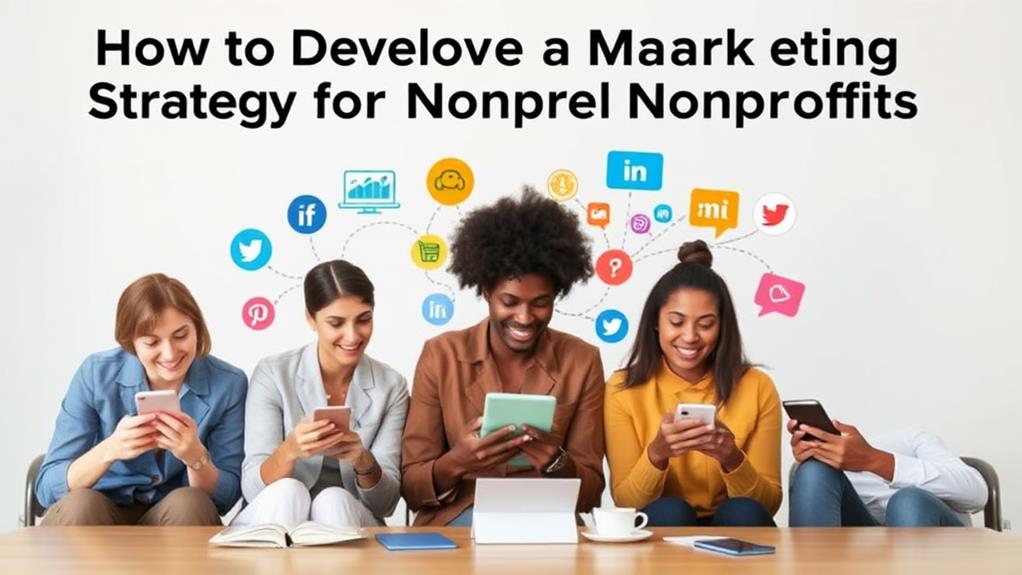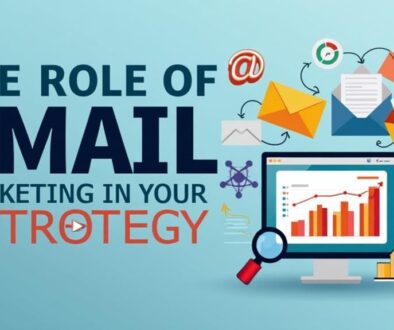How to Develop a Marketing Strategy for Nonprofits
To develop an effective marketing strategy for nonprofits, begin by clearly articulating your mission and vision. This foundation will guide decisions and engage stakeholders. Next, identify your target audience through demographic and behavioral analysis to tailor messaging. Assess current marketing efforts, setting specific objectives for awareness, engagement, and fundraising. Craft a unique value proposition that resonates emotionally with supporters. Utilize social media and build strategic partnerships to amplify your reach. Regularly measure and evaluate your success to refine strategies. Embracing these principles will enhance your impact, leading to deeper community connections and support—understanding how to implement these insights can transform your approach.
Key Takeaways
- Clearly define your mission and vision to guide decision-making and align with community needs.
- Identify and analyze your target audience's demographics, motivations, and preferred communication methods.
- Evaluate current marketing efforts for strengths and weaknesses, focusing on engagement metrics and competition.
- Set clear, measurable objectives for awareness, engagement, fundraising, and advocacy to track progress.
- Develop compelling impact stories that resonate emotionally and showcase the tangible benefits of your organization's work.
Understand Your Mission and Vision

Understanding your mission and vision is essential for nonprofits aiming to engage stakeholders effectively and drive impactful initiatives. A clear mission serves as the foundation of your organization, providing a focused purpose that informs decision-making and aligns activities. Conversely, a defined vision paints a compelling picture of the future you aspire to create, igniting passion and commitment among stakeholders.
Mission alignment and vision clarity are critical tenets of effective nonprofit operations. When an organization clearly articulates its mission, stakeholders—from donors to volunteers—can easily understand and resonate with its objectives. This alignment fosters a sense of community, inviting supporters to join in a shared cause, enhancing collective motivation. Additionally, it enables nonprofits to craft a narrative that speaks powerfully to the values and aspirations of potential allies.
Furthermore, vision clarity spurs innovation and creativity within organizations. A well-communicated vision can inspire creative approaches to problem-solving, leading to transformative initiatives that transcend conventional methods. It not only attracts funding and resources but nurtures an environment conducive to collaboration, where diverse voices contribute to the mission's fulfillment.
Ultimately, by refining mission alignment and ensuring vision clarity, nonprofits lay the groundwork for meaningful engagement with stakeholders. This strategic understanding cultivates a robust ecosystem of support, propelling the organization toward its goals while upholding the ideals of freedom and empowerment that lie at the heart of the nonprofit sector.
In this way, your mission and vision become crucial assets in your marketing strategy.
Identify Target Audience
With a clearly defined mission and vision serving as your organization's compass, the next step is to pinpoint your target audience. Identifying this audience is vital for effective relationship building and maximizing your outreach impact. By focusing on demographic segmentation, you can create precise audience personas that capture the nuances of potential supporters, volunteers, and beneficiaries. This allows for tailored engagement tactics that resonate deeply within distinct groups.
Here are four essential aspects to take into account when identifying your target audience:
- Demographics: Understand age, gender, income level, and education to tailor your message effectively.
- Behavior Analysis: Examine patterns in potential supporters' engagement, such as past donations and community involvement, to tailor your approach.
- Communication Preferences: Identify how your audience prefers to engage—whether through emails, social media, or face-to-face interactions—to deliver meaningful messages.
- Donor Motivations: Recognize the underlying reasons why individuals connect with your cause, ensuring your narratives speak to their values and aspirations.
Utilizing feedback mechanisms will also enrich your understanding, enabling you to refine outreach channels and engagement strategies continuously.
By fostering community involvement, your nonprofit can cultivate a sense of ownership among supporters, empowering them to advocate for your mission.
Ultimately, identifying your target audience is not just about outreach; it's about building lasting relationships that amplify the freedom and impact of your organization's efforts.
Analyze Current Marketing Efforts

In the dynamic landscape of nonprofit marketing, a critical examination of current efforts is essential for leveraging strengths and addressing weaknesses. Conducting a competitive analysis provides valuable insights into how other organizations are engaging similar audiences and can help pinpoint areas where your nonprofit can distinguish itself.
Audience segmentation plays a pivotal role in optimizing outreach strategies. By understanding the numerous demographics within your supporter base, you can tailor messages that resonate more profoundly, thereby enhancing brand awareness.
Additionally, evaluating your digital presence is critical. Analyzing website traffic, social media engagement, and email open rates will illuminate which platforms resonate best with your audience.
Engagement metrics serve as essential indicators of your current impact. Consider reviewing metrics such as volunteer participation rates and community involvement levels, as they reveal how effectively your organization fosters relationships and motivates action.
Scrutinizing your fundraising tactics is equally important. Are they effectively driving donations, or is there room for innovation? Experimenting with different approaches, such as peer-to-peer fundraising or online fundraising events, may yield better results.
Lastly, make certain that your current outreach strategies embody a spirit of inclusivity and collaboration. By doing so, your nonprofit can cultivate a robust network of supporters who feel personally connected to your mission.
Set Clear Objectives
A nonprofit's success often hinges on the clarity of its objectives, as these goals provide direction and purpose for marketing efforts. Setting clear objectives not only galvanizes your team but also guarantees that your mission resonates with your audience.
To effectively sculpt these objectives, consider employing established goal-setting frameworks such as SMART (Specific, Measurable, Achievable, Relevant, Time-Bound).
When formulating your objectives, focus on the following key areas:
- Awareness: Aim to enhance visibility through specific campaigns or outreach initiatives, thereby expanding your audience reach.
- Engagement: Set targets for meaningful interactions that reflect deeper connections with stakeholders, amplifying your message and impact.
- Fundraising: Establish concrete financial goals, directing efforts towards specific fundraising events or initiatives to achieve sustainable growth.
- Advocacy: Create objectives around policy influence or social change, measuring success by the depth of impact and community involvement.
To guarantee that these objectives translate into actionable results, it is vital to define clear performance metrics. By evaluating these metrics, nonprofits can assess their progress and adapt strategies accordingly, fostering an environment of continuous learning and improvement.
Embracing structured goal-setting frameworks not only streamlines focus but also cultivates an empowered community that yearns for freedom, driving meaningful change across all levels.
Through clarity in objectives, your nonprofit can best serve its mission and stakeholders, setting the stage for lasting impact and sustainable success.
Develop Unique Value Proposition

To effectively develop a unique value proposition, nonprofits must first identify their target audience, ensuring that messaging resonates with those who are most likely to engage and contribute.
Highlighting impactful stories not only illustrates the tangible differences made by the organization but also fosters a deeper emotional connection with supporters.
Additionally, a clearly articulated mission serves as the foundation for this proposition, guiding the narrative and differentiating the nonprofit in a crowded marketplace.
Identify Target Audience
Identifying the target audience is essential for nonprofits seeking to establish a compelling unique value proposition, as it allows organizations to tailor their messaging effectively.
Conducting a thorough demographic analysis and audience segmentation helps pinpoint who resonates with your mission. Understanding varied engagement preferences and communication styles is critical, as it fosters connections that inspire action.
To craft an impactful strategy, consider these four key components:
- Behavioral Insights: Analyze past interactions to understand how different segments engage.
- Geographic Targeting: Determine the locations of your potential supporters to focus local efforts effectively.
- Interest Alignment: Identify shared values with your audience to strengthen relational bonds.
- Donor and Volunteer Demographics: Understand what motivates your donors and volunteers to align your messaging with their aspirations.
Highlight Impact Stories
Highlighting impact stories serves as a powerful mechanism for nonprofits to develop a unique value proposition that resonates with their audience. By weaving together compelling narratives around the lives transformed through their initiatives, nonprofits can capture the essence of their mission and the profound difference they make in the community.
These stories not only showcase the tangible results of their efforts but also foster an emotional connection with potential supporters.
Donor testimonials play a vital role in amplifying these narratives. When existing supporters share their personal experiences and the positive changes they've witnessed, it bolsters credibility and encourages community engagement.
Potential donors, motivated by the desire to contribute to meaningful change, are more likely to respond to stories that illustrate the impact of their contributions.
To elevate their marketing strategy, nonprofits should prioritize creating a consistent stream of impactful stories across their channels. Capturing diverse voices from beneficiaries and volunteers enriches the narrative landscape, acknowledging the broader community's involvement.
Ultimately, by effectively showcasing these impact stories, nonprofits not only define their unique value proposition but also inspire action, inviting others to join in their mission for freedom and empowerment.
Articulate Mission Clearly
Clearly articulating a nonprofit's mission is essential for establishing a unique value proposition that distinguishes it in a competitive landscape. A well-crafted mission statement serves as the foundation for clear communication, ensuring that stakeholders understand the organization's goals and aspirations.
To effectively convey your nonprofit's mission, consider the following four elements:
- Conciseness: A mission statement should be brief, ideally one to two sentences, capturing the essence of what your organization stands for.
- Clarity: Avoid jargon and complex language; the message must resonate easily with both supporters and beneficiaries.
- Relevance: Connect your mission statement to the needs of the community you serve, ensuring that it reflects genuine value.
- Inspirational: Infuse your mission with passion and purpose, motivating others to join in your cause and support your vision.
Establishing a clear mission statement not only elevates your nonprofit's visibility but also fosters a deeper connection with your audience.
Create Engaging Content Strategy
To foster a deeper connection with audiences, nonprofits must craft purpose-driven messaging that resonates with their core mission and values.
Incorporating visual storytelling techniques can greatly enhance the emotional impact of their content, making it more relatable and memorable.
Purpose-Driven Messaging
Crafting purpose-driven messaging is essential for nonprofits aiming to create a lasting impact and foster genuine connections with their audience. By prioritizing clarity and emotional resonance, organizations can guarantee their communications align with their mission while engaging supporters authentically.
To develop effective messaging, consider these key components:
- Mission Alignment: Guarantee that every piece of content reflects the core values and goals of your organization, reinforcing your purpose in the community.
- Emotional Connection: Utilize storytelling techniques that evoke feelings and illustrate how your work positively affects lives. This builds trust and encourages deeper engagement.
- Community Involvement: Highlight the voices of those directly impacted by your initiatives, promoting transparency and brand authenticity, which resonate with potential donors and volunteers.
- Feedback Mechanisms: Encourage responses from your audience to refine outreach initiatives continually. Their insights can shape future campaigns and enhance fundraising strategies.
Visual Storytelling Techniques
How can nonprofits harness the power of visual storytelling to create compelling narratives that resonate with their audiences? Effective visual narratives can greatly enhance emotional engagement, drawing audiences into the mission and values of the organization. By employing a storytelling framework, nonprofits can strategically map their messages, guaranteeing alignment with core objectives while fostering a deeper audience connection.
Key to successful visual storytelling is imagery selection, which should prioritize cultural sensitivity and relevance. This guarantees that the visuals employed do not merely attract attention, but also reflect the diverse backgrounds of the audience, promoting inclusiveness.
Additionally, multimedia integration—leveraging video, infographics, and photography—can amplify the impact visualization, showcasing the change your organization seeks to create.
To maintain brand consistency, visuals must be seamlessly aligned with existing messaging and organizational identity. This approach fosters trust and recognition among supporters.
By transcending traditional communication barriers, nonprofits can engage their audience on a profound level, nurturing a community that feels inspired to contribute to the cause.
Ultimately, effective visual storytelling not only captivates but transforms passive viewers into passionate advocates, driving mission-driven action.
Leverage Social Media Platforms

Social media platforms have become indispensable tools for nonprofits aiming to amplify their message and reach a broader audience. Utilizing these platforms effectively requires a strategic approach that focuses on brand consistency and audience engagement. By employing tailored platform-specific strategies, nonprofits can harness their full potential.
To optimize social media efforts, consider the following strategies:
- Content Scheduling: Plan and organize posts to guarantee regular interaction without overwhelming followers. Consistency is key to maintaining interest and engagement.
- Hashtag Campaigns: Leverage trending hashtags to increase visibility. Craft unique campaigns that resonate with your audience while aligning with your nonprofit's mission.
- Influencer Collaborations: Partner with influencers who share your values. These collaborations can expand your reach and add credibility to your message.
- Paid Advertising: Invest in targeted social media ads. This can effectively reach potential supporters while providing invaluable insights through social media analytics.
Harnessing these techniques allows nonprofits to strategically engage with their communities. Emphasizing audience engagement through well-crafted content not only drives action but fosters a sense of belonging.
By implementing these strategies, nonprofits can enhance their online presence, guaranteeing their missions resonate widely. With social media as a conduit for their brand narrative, organizations can inspire action and foster a loyal following committed to their cause.
In this ever-evolving digital landscape, adapting and refining your approach is paramount to achieving lasting impact.
Build Strategic Partnerships
Building strategic partnerships is vital for nonprofits seeking to amplify their impact.
By identifying potential partners whose missions align with their own, organizations can leverage shared resources, networks, and expertise to strengthen collaborative efforts.
These alliances not only enhance visibility but also foster innovation, enabling nonprofits to achieve their goals more effectively.
Identify Potential Partners
Identifying potential partners is a critical step in creating effective strategic alliances for nonprofits, as collaboration can greatly amplify an organization's impact.
By aligning with others who share your mission and values, nonprofits can access new resources, expand outreach, and ultimately achieve greater social change.
To identify these partners, consider the following criteria:
- Shared Mission and Vision: Look for organizations that resonate with your nonprofit's core values and objectives.
- Complementary Strengths: Seek partners that bring unique resources or expertise, enhancing your capacity while broadening your reach.
- Geographic Alignment: Focus on organizations operating in similar regions or communities, creating localized collaboration opportunities that foster mutual support.
- Demonstrated Commitment to Collaboration: Identify entities with a proven track record of working effectively with others, indicating a willingness for mutual benefit.
In this search for potential partners, remain open to diverse possibilities—sometimes the most innovative alliances arise from the most unexpected sources.
Strengthen Collaborative Efforts
Once potential partners have been identified, nonprofits must focus on strengthening collaborative efforts to maximize the benefits of strategic partnerships. Engaging in collaborative fundraising initiatives not only broadens funding avenues but also fosters a sense of community. By organizing joint events, nonprofits can leverage combined resources, increase visibility, and amplify their collective impact.
Shared resources are essential in reducing costs and enhancing efficiency. When partners pool financial and human capital, they create a powerful synergy that enhances community engagement. Implementing cross-promotion strategies can further elevate each organization's reach, ensuring that stakeholders are informed and involved.
A successful partnership thrives on open communication and aligned goals. Nonprofits should embrace volunteer initiatives that draw in community members, strengthening the bond between organizations and their audience. Through unified efforts, nonprofits can highlight partnership benefits, attracting new supporters and sustaining existing donor relationships.
Ultimately, solidifying these collaborative efforts cultivates a culture of mutual support, enriching the nonprofit sector overall. By empowering one another, organizations not only achieve their missions but also inspire a liberated spirit of cooperation and shared success within the community.
Measure and Evaluate Success

Measuring and evaluating success are essential components of any effective marketing strategy for nonprofits, as these processes provide insights into the impact of initiatives and the overall health of the organization. Organizations must focus on impact measurement to assess the effectiveness of their programs, guiding them towards strategic adjustments that resonate with their mission.
Utilizing robust evaluation frameworks allows nonprofits to establish clear performance metrics, ensuring they align with broader success indicators. The process of measuring success should integrate feedback loops, enabling ongoing stakeholder engagement and fostering relationships that are crucial for sustainable growth.
Here are four key practices to incorporate in your evaluation strategy:
- Data Analysis: Regularly analyze data on outreach efforts, fundraising activities, and volunteer engagement to gauge effectiveness.
- Outcome Assessment: Utilize structured approaches to evaluate the tangible results of initiatives, reinforcing a culture of continuous improvement.
- Stakeholder Insights: Actively involve stakeholders in the evaluation process to gain diverse perspectives and foster a collaborative environment.
- Define Success Indicators: Clearly articulate what constitutes success for your organization, ensuring everyone is aligned on goals and objectives.
Adjust and Improve Marketing Strategy
Regularly adjusting and improving your marketing strategy is fundamental for a nonprofit's sustained success in a rapidly changing environment. To thrive, nonprofits must cultivate robust donor engagement and volunteer outreach programs that reflect evolving community interests and values.
By developing agile fundraising tactics and event promotion strategies, organizations can adapt to shifts in stakeholder communication demands, thereby enhancing their overall impact.
A key component of this iterative process lies in fostering brand consistency across all touchpoints. This guarantees that your message resonates clearly and effectively with your audience, regardless of the platform.
Leveraging a strong digital presence is also essential; it allows nonprofits to reach wider demographics through audience segmentation. By identifying various audience segments, organizations can tailor their communications, making outreach efforts more relevant and compelling.
Moreover, implementing feedback loops is critical for informed decision-making. Actively seeking input from donors, volunteers, and beneficiaries can provide invaluable insights that guide strategic adjustments.
Frequently Asked Questions
How Can We Engage Volunteers in Our Marketing Strategy?
Engaging volunteers in your marketing strategy is essential for enhancing operational success.
By leveraging social media engagement, organizations can create compelling content that resonates with potential volunteers, showcasing the impact of their contributions. This approach not only aids in volunteer recruitment but also fosters a strong community connection.
Additionally, encouraging volunteers to share their experiences on social platforms can amplify outreach, transforming them into passionate advocates for your mission and expanding your organization's visibility.
What Budget Considerations Should Nonprofits Have for Marketing?
Marketing without a budget is akin to sailing without a compass; both lack direction and purpose. Nonprofits must conduct a thorough cost analysis to align their marketing efforts with available funding sources.
Prioritizing expenditures—such as digital outreach, print materials, or event promotion—can optimize limited resources. Additionally, exploring grants and partnerships can enhance financial flexibility, enabling nonprofits to amplify their messaging while staying true to their mission of fostering freedom and community engagement.
How Do We Incorporate Storytelling Into Our Marketing Approach?
Incorporating storytelling into your marketing approach involves utilizing narrative techniques to create compelling and relatable content.
By weaving personal experiences and testimonials into your messaging, you foster an emotional connection with your audience. This approach not only engages potential supporters but also promotes a shared vision.
Craft stories that highlight the impact of your work, appealing to the audience's sense of empathy and desire for freedom, thereby encouraging advocacy and support for your cause.
What Role Does Branding Play in Nonprofit Marketing Strategies?
Branding in nonprofit marketing is akin to planting a flag on the battlefield of social impact; it signals purpose and direction.
A strong brand identity fosters mission alignment, enhancing audience perception and engagement.
Visual consistency amplifies recognition, while creating an emotional connection cultivates trust building.
Each interaction with the brand reinforces its values, empowering stakeholders to join the cause, ensuring that the nonprofit not only exists but thrives in the space it occupies.
How Can We Effectively Use Email Marketing for Nonprofit Outreach?
Effective email marketing for outreach hinges on strategic email segmentation to tailor content to specific donor interests and behaviors.
This personalized approach fosters deeper donor engagement, ensuring recipients feel valued and understood. By analyzing demographics and preferences, organizations can craft targeted messaging that resonates, encouraging participation and support.
Highlighting successes and calls to action within segmented lists not only informs but also inspires commitment, ultimately driving stronger connections between the nonprofit and its supporters.
Conclusion
In the domain of nonprofit organizations, a well-structured marketing strategy serves as a beacon guiding missions toward success. As the adage suggests, "Many hands make light work," the collaboration of targeted efforts, strategic partnerships, and social media engagement amplifies visibility and impact. By continuously measuring success and refining approaches, nonprofits can cultivate stronger connections and foster community support, ultimately ensuring a sustainable future for their essential initiatives. Effective marketing is not merely a tactic; it is a transformative process.




